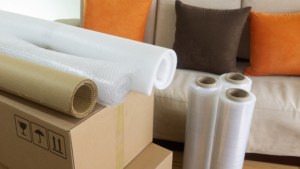Packing Tips for Hassle-Free Storage
Before storing your items, it is crucial to take a few steps to ensure their safety. Begin by decluttering and organizing your belongings before packing them.
This will make the packing process easier and ensure that you do not store any unnecessary items.
Following the packing tips and using sturdy boxes and appropriate packing materials is crucial to protect fragile items. This will help prevent any damage during transportation or while in storage.
Once you have packed your items, label each box with its contents and destination to make it easier to locate specific items when needed.
Efficient use of space is critical to maximizing your storage area. Stack boxes carefully and make use of vertical storage options whenever possible. This will allow you to store more items without taking up additional space.
When choosing a storage facility, it is essential to consider climate control and temperature-sensitive items. If your items are sensitive to temperature or humidity changes, you may need to opt for a climate-controlled unit.
This will help maintain the condition of your items and prevent any damage due to extreme temperatures.
How do I pack for SMARTBOX storage?
Planning how to pack your items into the boxes is worthwhile at this stage in your storage process. Unit sizes are determined by price, so you can save money by assessing what you have to store and planning to pack it efficiently. A smaller and well-packed one will be cheaper than a poorly organised one.
There are steps you should take care of when storing – these are your belongings, and there are measures you can take, apart from careful packing, that will help protect them during their time in the facility.
Make your packing much more accessible and protect your goods while they’re in storage by taking note of these Packing Tips:
Make packing easier by planning. Gather up plenty of sturdy, corrugated cartons, packing paper, bubble wrap, sealing tape, marker pens, and furniture covers.
Boxes that are tightly sealed with packing tape will prevent dust from entering.
Wrap furniture legs with protective bubble wrap, covers, or pads to prevent scratching. Leave slipcovers on upholstered chairs and cover them with plastic chair covers. Tape or tie bed rails together. Mark the pieces for easier assembly later—place covers or plastic bags on mattresses to keep them clean during storage.
Label boxes on all sides for easy identification. For reference, keep a list (pictures and descriptions) at your home or office. Mark all boxes containing fragile items. Ensure fragile boxes are placed on top of heavier, less delicate boxes.
Use valuable space inside dresser drawers and larger appliances, such as stoves and refrigerators, to store small items such as towels, linens, and small, fragile items—secure items in the drawer by filling empty spaces with towels or packing paper.
Pack as much as you can in the same size boxes.
Fill boxes tightly, but take care to neither overpack nor under a pack. (Bulging cartons tip when stacked, while half-full boxes tend to collapse). Use wadded-up newsprint, bubble wrap, rags, towels, or blankets to fill empty spaces for maximum protection, and seal cartons with tape.
Pack heavy items such as books and tools in small boxes. Limit the weight of all cartons, regardless of size, to 25kg for easier handling. Or less.
Clean and dry appliances before storing. Secure all movable parts with paper or wedges, and wrap a paper pad around each item for protection. During transport tape, all doors shut, but remember to wedge them open for storage.
Pack books flat to protect their spines. Line cartons with plastic and fill empty spaces with packing paper.
Use lots of tissue to pack dishes and glassware. Place a layer of packing paper inside the bottom and top of the cartons. Wrap each dish and glass separately and cushion them with crumpled paper. Plates are best stacked on the edge.
Hang clothes and draperies in wardrobe boxes.
Pack lamps and lampshades in individual boxes. Use plenty of clean paper or clothing for padding.
It is recommended to pad mirrors and paintings with paper and pack them in special mirror boxes or large boxes, which should be appropriately marked.
You can request No Obligation Quote
